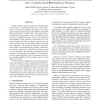24 search results - page 4 / 5 » SEPAS: a highly accurate energy-efficient branch predictor |
CF
2007
ACM
2007
ACM
Adaptive VP decay: making value predictors leakage-efficient designs for high performance processors
13 years 11 months ago
Energy-efficient microprocessor designs are one of the major concerns in both high performance and embedded processor domains. Furthermore, as process technology advances toward d...
ISCA
1997
IEEE
13 years 11 months ago
1997
IEEE
As the issue rate and pipeline depth of high performance superscalar processors increase, the amount of speculative work issued also increases. Because speculative work must be th...
EUROPAR
1999
Springer
13 years 12 months ago
1999
Springer
Two-level predictors deliver highly accurate conditional branch prediction, indirect branch target prediction and value prediction. Accurate prediction enables speculative executio...
MICRO
1998
IEEE
13 years 12 months ago
1998
IEEE
To achieve highly accurate branch prediction, it is necessary not only to allocate more resources to branch prediction hardware but also to improve the understanding of branch exe...
HPCA
2008
IEEE
14 years 8 months ago
2008
IEEE
A path confidence estimate indicates the likelihood that the processor is currently fetching correct path instructions. Accurate path confidence prediction is critical for applica...

